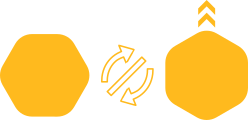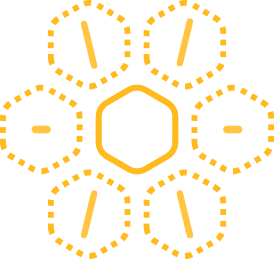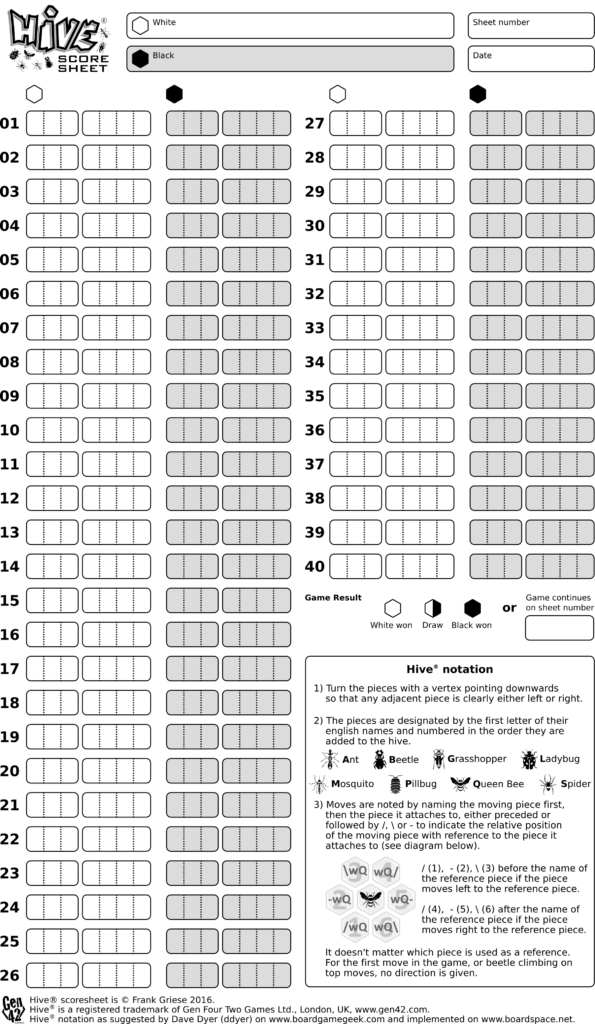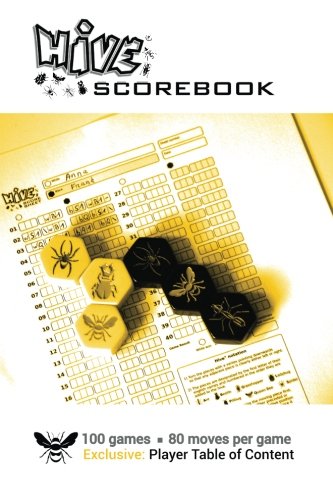Notation is a convenient way to keep track of games, so that you can replay them to study tactics, understand mistakes, and communicate complex moves clearly and succinctly.
In Hive®, there is no board. You could describe a game using a virtual hexagonal grid and record the coordinates of pieces as they enter the game or move. While this is fairly easy for a computer, it is unpractical for a human. A more practical approach is to identify the space where a piece enters the game or moves to by referencing a neighboring piece.
The prevailing notation system for Hive®, and the current de facto standard, was developed by Dave Dyer for his digital implementation of Hive® on boardspace.net.
Here is how it works. First, turn all the pieces with a tip pointing upwards so that any adjacent piece is clearly either left or right.

The pieces are designated by the first letter of their English names in uppercase.
A = Ant
B = Beetle
G = Grasshopper
L = Ladybug
M = Mosquito
P = Pillbug
Q = Queen Bee
S = Spider
The capital letter is preceded by w or b to indicate the piece’s color.
Pieces are numbered in the order they are added into the game. For example, wA1 is the first Ant white placed.
Moves are noted by naming the moving piece first, then the piece it attaches itself to, either preceded or followed by one of three symbols /, \ or -. The symbol indicates the direction of the moving piece relative to the reference piece.

The direction symbol is placed before the reference piece when the moving piece attaches itself to the left of the reference piece.
In contrast, the direction symbol is placed after the reference piece when the moving piece attaches itself to the right of the reference piece.
It doesn’t matter which piece is used as a reference. In many cases, there will be several choices. Hence, there may be multiple ways to note the same move.
For the first move in the game, only the piece itself is identified.
For beetle moves on top of other pieces, no direction is given. Only the reference piece (the piece that the Beetle climbs on top of) is recorded.
Notation example:
1. wG1 White places his first Grasshopper.
2. bG1 wG1- Black places his first Grasshopper to the right of white’s Grasshopper.
3. wA1 \wG1 White places his first Ant to the top left of his Grasshopper.
4. bQ bG1/ Black places his Queen bee to the top right of his Grasshopper.
5. wQ /wG1 White places his Queen bee to the bottom left of his Grasshopper.
6. bS1 bG1\ Black places his first Spider to the bottom right of his Grasshopper.
7. wA1 bQ/ White moves his Ant to the top right of the black Queen bee.
8. bS1 /wQ Black moves his Spider to the bottom left of the white Queen bee.
9. wB1 wA1- White introduces his first Beetle to the right of his Ant.
10. bB1 bG1- Black introduces his first Beetle to the right of his Grasshopper.
11. wB1 wA1 The white Beetle moves on top of the white Ant.
First 11 moves taken from the game jessj48 against ringersoll U!HV-jessj48-ringersoll-2013-09-14-0120 played on boardspace.net
You can keep record of games you played by using a scoresheet. Maintaining an accurate and legible scoresheet library can be a valuable learning tool and a record of your progress over time.

Here is a free sample scoresheet template you can download and use to record your games. The sheet has a handy summary of the Hive® notation system we just presented, and a two-column layout that will assist you in writing down all the moves made during the game.
We also offer a Hive® Scorebook in paperback. This is the perfect way to record your games in Hive® notation. It features 100 sheets with room for 80 moves per sheet. The easy Player Table of Contents helps you organize your game records. You can look up games by sheet number, just as you would use the table of contents of a normal book.

